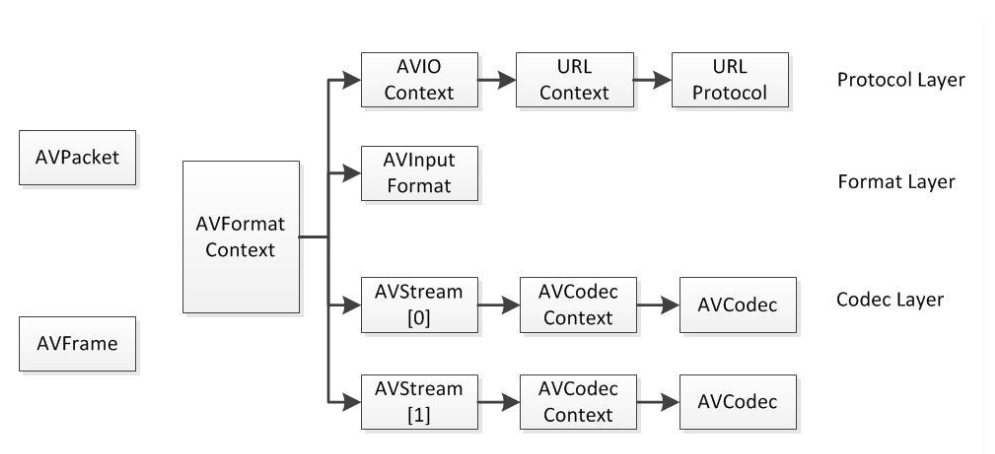FFmpeg 6.0 中 AVIOContext 结构体
 AVIOContext 是 FFmpeg 管理输入输出数据。
AVIOContext 是 FFmpeg 管理输入输出数据。
AVIOContext
1
2
3
4
5
6
7
8
9
10
11
12
13
14
15
16
17
18
19
20
21
22
23
24
25
26
27
28
29
30
31
32
33
34
35
36
37
38
39
40
41
42
43
44
45
46
47
48
49
50
51
52
53
54
55
56
57
58
59
60
61
62
63
64
65
66
67
68
69
70
71
72
73
74
75
76
77
78
79
80
81
82
83
84
85
86
87
88
89
90
91
92
93
94
95
96
97
98
99
100
101
102
103
104
105
106
107
108
109
110
111
112
113
114
115
116
117
118
119
120
121
122
123
124
125
126
127
128
129
130
131
132
133
134
135
136
137
138
139
140
141
142
143
typedef struct AVIOContext {
/**
* 私有选项类。
*
* 如果此 AVIOContext 由 avio_open2() 创建,则会设置 av_class 并
* 将选项传递给协议。
*
* 如果此 AVIOContext 是手动分配的,则调用者可以设置 av_class。
*
* 警告 - 此字段可能为 NULL,在这种情况下,请确保不要将此 AVIOContext
* 传递给任何 av_opt_* 函数。
*/
const AVClass *av_class;
/*
* 以下显示了 buffer、buf_ptr、
* buf_ptr_max、buf_end、buf_size 和 pos 之间的关系,在读取和写入时
* (因为 AVIOContext 用于两者):
*
**********************************************************************************
* 读取
**********************************************************************************
*
* | buffer_size |
* |---------------------------------------|
* | |
*
* buffer buf_ptr buf_end
* +---------------+-----------------------+
* |/ / / / / / / /|/ / / / / / /| |
* 读取缓冲区: |/ / 已使用 / | 待读取 /| |
* |/ / / / / / / /|/ / / / / / /| |
* +---------------+-----------------------+
*
* pos
* +-------------------------------------------+-----------------+
* 输入文件: | | |
* +-------------------------------------------+-----------------+
*
*
**********************************************************************************
* 写入
**********************************************************************************
*
* | buffer_size |
* |--------------------------------------|
* | |
*
* buf_ptr_max
* buffer (buf_ptr) buf_end
* +-----------------------+--------------+
* |/ / / / / / / / / / / /| |
* 写入缓冲区: | / / 待刷新 / / | |
* |/ / / / / / / / / / / /| |
* +-----------------------+--------------+
* buf_ptr 可能位于此处
* 由于向后查找
*
* pos
* +-------------+----------------------------------------------+
* 输出文件: | | |
* +-------------+----------------------------------------------+
*
*/
unsigned char *buffer; /**< 缓冲区的开头。 */
int buffer_size; /**< 最大缓冲区大小 */
unsigned char *buf_ptr; /**< 缓冲区中的当前位置 */
unsigned char *buf_end; /**< 数据的结尾,可能小于
buffer+buffer_size,如果读取函数返回
请求的数据少于请求量,例如,对于尚未接收更多数据的流。 */
void *opaque; /**< 私有指针,传递给读取/写入/查找/...
函数。 */
int (*read_packet)(void *opaque, uint8_t *buf, int buf_size);
int (*write_packet)(void *opaque, uint8_t *buf, int buf_size);
int64_t (*seek)(void *opaque, int64_t offset, int whence);
int64_t pos; /**< 当前缓冲区在文件中的位置 */
int eof_reached; /**< 如果由于错误或文件结尾而无法读取,则为 true */
int error; /**< 包含错误代码,如果未发生错误,则为 0 */
int write_flag; /**< 如果打开以供写入,则为 true */
int max_packet_size;
int min_packet_size; /**< 在刷新之前尝试至少缓冲这么多数据。 */
unsigned long checksum;
unsigned char *checksum_ptr;
unsigned long (*update_checksum)(unsigned long checksum, const uint8_t *buf, unsigned int size);
/**
* 暂停或恢复网络流协议的播放 - 例如,MMS。
*/
int (*read_pause)(void *opaque, int pause);
/**
* 使用指定 stream_index 将流中的时间戳定位到指定时间戳。
* 一些不支持定位到字节位置的网络流协议需要此功能。
*/
int64_t (*read_seek)(void *opaque, int stream_index,
int64_t timestamp, int flags);
/**
* AVIO_SEEKABLE_ 标志的组合,或者当流不可查找时为 0。
*/
int seekable;
/**
* avio_read 和 avio_write 应尽可能直接满足
* 而不是通过缓冲区,并且 avio_seek 将始终
* 直接调用底层查找函数。
*/
int direct;
/**
* 允许的协议的逗号分隔列表。
*/
const char *protocol_whitelist;
/**
* 禁止的协议的逗号分隔列表。
*/
const char *protocol_blacklist;
/**
* 用作 write_packet 的回调。
*/
int (*write_data_type)(void *opaque, uint8_t *buf, int buf_size,
enum AVIODataMarkerType type, int64_t time);
/**
* 如果设置,不要分别为 AVIO_DATA_MARKER_BOUNDARY_POINT 调用 write_data_type,
* 而是忽略它们并将它们视为 AVIO_DATA_MARKER_UNKNOWN(以避免从回调中返回不必要的小数据块)。
*/
int ignore_boundary_point;
/**
* 写入缓冲区中向后查找之前的最大到达位置,
* 用于跟踪已写入的数据,以便稍后刷新。
*/
unsigned char *buf_ptr_max;
/**
* 此 AVIOContext 读取字节的只读统计信息。
*/
int64_t bytes_read;
/**
* 此 AVIOContext 写入字节的只读统计信息。
*/
int64_t bytes_written;
} AVIOContext;
本文由作者按照 CC BY 4.0 进行授权